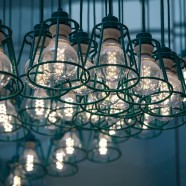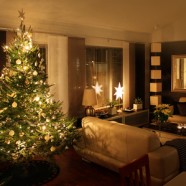How to Upgrade Your Outdoor Lighting to Achieve Energy Savings
One of the best money saving tips you can make to lower your energy bill is to upgrade your outdoor lighting. Switching your lighting from traditional bulbs to more efficient LED lights can save you hundreds of dollars each year. Energy efficiency is the selling point of all LED lighting systems, but these lights can save you money in many different ways. Whether you have safety spotlights on your building or landscape lighting at the base of your property, you’ll enjoy energy savings for multiple reasons when you upgrade them to LED lighting.
Long Life
LED bulbs last about ten times as long as fluorescents, and even longer than that compared to traditional incandescent bulbs. When you’re not running out for light bulbs every few months, the savings can add up.
Durability
Traditional bulbs are built with a fragile filament, which makes them much easier to break. If you have birds pecking at your spotlight or lawnmowers running into your landscape ground lights, they’re apt to break on a regular basis. LEDs are solid, and can withstand a surprising amount of jarring and bumping.
Coolness
LED lights don’t heat up like traditional bulbs do. If your outdoor lights are a part of your landscape design, your expensive shrubbery can get dried out if the heat from the lights is concentrated on them for too long. Allowing your landscape to grow and mature without needing replacement plants is another way you’ll save with LED replacements.
Efficiency
You’ll see the largest energy savings from simple usage when comparing LED bulbs with incandescents or CFL varieties. LED replacements will use a fraction of the power, sometimes as low as 1/30th of the energy usage. While they use up much less power on a daily basis, LEDs are as bright or brighter than the traditional lights you’ll be replacing.
Increased Safety
You may see such large energy savings when you replace your current outdoor lighting with LED bulbs you’ll be able to add more lights around your property. Instead of just shining a light on the driveway or front door, you’ll be able to afford bright safety lights around the entire perimeter. A brighter yard is safer for people to walk around in after dark, and is also a deterrent for burglars and thieves.
Green Technology
LED lights are so efficient that you may be able to remove yours from the grid completely and hook them up to a small solar generator. A few unobtrusive solar cells can capture enough power to run the outdoor lights for many suburban homes. It’s free power to light your property, and a good safety addition in case of power outages.
Read More4 Ways to Use LED Retrofits to Promote Energy Conservation
Advocates of clean technology have long advised LED retrofits for turning your business greener, but they don’t always mention a secondary benefit: the conservation of electricity. Buildings use up about 40 percent of the world’s power every day, and anything you can do to get that number down will give you a positive impact on your bottom line.
Mercy Philadelphia Hospital installed LED exit lights, photo light controls, and other LED retrofits, and they’re now saving over $20,000 a year in energy costs. You don’t have to own a hospital or other large business to see savings and energy conservation with LED retrofits. Even small changes can make a noticeable difference on your bottom line.
Holiday Decorations
The increase in your power bill in December isn’t completely due to the lower temperatures. Many businesses make a point of decorating their buildings for the holidays. Depending on the amount of lights and ornaments you use, you can save a significant amount of energy for the month by using LED lights instead of the traditional incandescent variety.
Older style lights use about 40 watts per string, while LED lights are much lower, using about 4.8. Your total savings depend on your Christmas cheer and how much you want to celebrate with the neighborhood, but typical savings can run from $10 in the hundreds of dollars for the month of December.
Outdoor Lighting
Apartment complexes, nursing homes, and small business can all reduce their energy usage by installing LED retrofits into their existing outdoor lighting schemes. Buildings with landscape feature lighting, lights along pathways, spotlights to illuminate walkways and expanses of grass, and motion sensor anti-crime devices can all benefit from being changed over to a set of LED bulbs.
Changing out 200 typical incandescent bulbs can save enough energy in one year to power the average home in the United States for that same year. In addition, since LED bulbs last about 20 times as long as incandescent varieties, you’ll save time and money on labor for changing burnt out bulbs.
Parking Lot Lighting
Many parking lots suffer from dark corners and edges while the center is almost too bright underneath the traditional lights. Switching to LED parking lot lights can solve this problem, as the light from these bulbs diffuses more evenly underneath the area in which they’re installed. Switching out your bulbs to LEDs will give you more uniform lighting to increase lot safety, as well as saving a significant amount of energy on a monthly basis.
You can find additional savings by installing bi-level controls on your LED lights. These lights run normally at a dimmer level, then brighten up considerably when motion detectors sense movement in the lot beneath. Your lot will still be constantly lit, unlike with typical motion sensors, but you’ll save energy by not having the lights at full power all night long.
Indoors
You may see the largest savings of all by doing LED retrofits inside your business. Businesses across the country are seeing amazing energy savings simply by switching out their old traditional bulbs for more efficient LED versions. GM’s Lordstown, Ohio, complex is currently undergoing the world’s largest LED retrofit project. With about a third of the project done, GM has already seen an 80 percent drop in energy usage in one factory in the complex.
It’s doubtful that you have as many lights in your business as GM does in theirs, but you can perform the same LED retrofit on a smaller scale and still see the same type of energy savings.
Read MoreWant a Free Vacation? Tips for Electricity Savings You Can Bank On
Money has rarely been tighter, which can make you feel more stressed out every day. It’s the perfect scenario for needing a vacation, but who can afford a weekend away? You can, if you follow these small changes and stick with them for a year. Some of them you can install with the help of a licensed electrical contractor, but the rest are switches you can make yourself. Whether you’d like a few days away with the kids or a romantic weekend away from home, you can bank enough money from electricity savings to pay for it by the end of the year.
Changes to Make with Your Electrical Contractor’s Help
Even the handiest handyman (or -woman) needs help with some jobs, especially when it comes to installing electrical appliances. It’s much safer to trust a licensed electrician to do a professional job than to do even a competent amateur job. You’ll know the job is done right, and you’ll save money by avoiding the inevitable redo that shoddy jobs call for. Some of the ways your electrician can help you save money are:
- Installing a hot water heater timer. You’re not home all the time, and you definitely don’t take showers all hours of the day and night. Why spend money heating water you’re not going to use. An electrician can install a water heater timer for a savings of about $25 per year.
- Get a smart meter. Check with your electricity company to find the availability of these meters in your area. If they’re available, your electrician can install them, replacing your old meter. These new, more sensitive meters have the ability to shut off power to your home for a short time, lightening the power load in times when it’s needed most for the community. Most electric companies offer a reward for using these meters, and you can achieve up to $140 a year in electricity savings by using one.
- Install smarter switches. Outdoor lighting can be a great safety feature on a house, but it costs a lot of money to have those lights running all night long. Have your electrician switch out the traditional lights for ones with a motion sensor switch. The lights will go on when anything moves around your property, and go back off when all is calm. Smarter switches can work inside the house, too. Set timers on the fans in your home, including a timer that will turn each fan off after a certain length of time. Adding these two details to your home can net you around $100 a year.
Changes You Can Do Yourself
Some changes are so simple you can do them yourself. You’ll save a surprisingly large amount of money making these easy changes, without ever having to consult a professional:
Buy Energy Star appliances. If you’re in the market for a new refrigerator or stove, do your research to find the most energy-efficient model that fits your lifestyle. Energy Star models show their average savings right on the label. These appliances can save you between $35 and $600 a year.
Service your air conditioner. This simple task doesn’t take a professional to complete it. If you hose out the inside, straighten the fins, lubricate the motor, and change the filter, you can save up to $65 next year.
Kill energy vampires. According to the Department of Energy, 75 percent of the electrical use by home electronics happens when they’re shut off. These appliances are always in stand-by mode, which takes a constant source of power to maintain. Unplugging your computer, stereo system, and television can cut around $100 from your bill each year.
Change your furnace filters. Yes, it’s time-worn advice, but that doesn’t make it useless. Changing a furnace filter is almost always a matter of sliding the old one out and sliding a replacement in. It takes about a minute, and saves you about $5 a month, or $60 every year.
Read MoreResidential Electrical Safety Tips for the Holidays
The holiday season sees a higher electrical usage in residential properties than almost any other time in the year. With lights and other decorations being added indoors and out, additional appliances being used to prepare holiday meals, and multiple new gifts being plugged in at the same time, homeowners need to be extra vigilant to keep safety in mind. Not only is higher residential electrical usage a source of higher utility bills, it’s also the source of accidents and fire damage that’s not often seen any other time of the year. Common sense and preparation are key to electrical safety during the holidays.
Cords
Most people reuse strings of lights and other holiday decorations over and over each year. While most decorations are meant to last for years, it’s crucial to inspect each one before using it. Cords can snap or wear, especially if stored in extreme temperatures, and fraying wires are a certain fire hazard. Once you’ve determined that all your cords are in good condition, take care when stringing them over your house of property. Make sure none of the cords are pinched underneath or behind heavy furniture or hidden under rugs where they can be stepped on and damaged, and always use tape to secure cords in place, never nails or staples.
Lights
Strings of lights may be the most common of all holiday decorations, but they can also be the largest source of power usage and fire hazards. When decorating your outside property with light strings, always plug the lights into a GFCI outlet to protect your property from damage due to electricity coming in contact with moisture. Never connect more than three strings of lights together, and wrap all connections with plastic wrap to keep snow and ice away. Drape lights over bushes carefully, making sure branches don’t come in contact with light bulbs. Consider replacing your old traditional strings of lights with the newer LED lights. LED holiday lights have a wide range of advantages:
- LED lights are brighter than traditional bulbs
- They come in a large variety of attractive colors
- They use much less power, making them less expensive to use
- LED light bulbs are cool to the touch when in use, reducing the danger of fire damage
Always use a wooden or fiberglass ladder when hanging holiday lights, and always turn off all lights before leaving home or going to bed.
Cooking
The holidays often mean parties and family dinners, and this calls for cooking larger amounts of food than during the rest of the year. Many people have small appliances, such as deep fryers, slow cookers, stand mixers, and blenders that only get used once a year. This additional usage can cut down on counter space, which can turn your kitchen into an electrical danger zone. Always plug appliances into an approved GFCI outlet. Do not string cords through dishwater or puddles, and keep them away from other appliances. Use one appliance at a time, or at least one per cooking area. Inspect each appliance, including the plug and cord, before using it, and unplug each one as soon as it’s no longer in use.
Other Tips
Keep residential electrical safety in mind throughout the holiday season while enjoying the time with friends and family. During cold winter days, keep electrical space heaters away from rugs, curtains, gifts, and holiday decorations. Test your smoke alarm and replace the batteries if needed. Avoid overloading electrical outlets with too many plugs; instead, use a power strip with a circuit breaker built in. Keep all electric cords out of reach of small children and chewing pets, and only allow responsible adults to plug in new toys and gifts for children to play with.
Read MoreElectrical Construction: What to Look For in a Licensed Electrician
Every new building, from commercial ventures to new homes, needs a solid electrical construction plan at its core. The professionals you hire begin with electrical blueprints, adding in the plans for wiring, construction, and testing of electrical components. With all the costs related to new construction, you might be considering using a general handyman or builder to take care of your new electrical needs. This can end up costing you more in the end for many reasons, from inefficient wiring plans to outright unsafe electrical systems. Electrical construction professionals have specialized training, and will make sure you get the quality job you need that lasts. When you’re ready to look for a licensed electrician, keep these ideas in mind to help you decide:
The Construction Job
Each licensed electrician is something of a specialist, even if he is proficient with many types of projects. Once you have decided exactly what type of job you need done, look for an electrical professional who specializes in jobs similar to the one you need done. Speak with others in your community who have had similar projects done, and ask for recommendations. Research local companies and ask them for examples of their work that you can look at. Knowing a licensed electrician is experienced with electrical construction jobs similar to yours is the base on which you’ll build a decision on who to choose.
Proficiency
The two most important aspects of an electrical construction job are safety and reliability. Electricians who work on your project must be proficient in these areas, and be trained and recognize the standards of quality and safety. Look for a licensed contractor who:
- Is familiar with the National Electric Code (NEC), which is the recognized safety standard adopted by the majority of local and state building inspection authorities.
- Is licensed, along with all of his employees, in the jurisdiction where your proposed project is to be located. The contractor should be aware that the project will be inspected by authorities in the project’s jurisdiction, who will expect all rules and guidelines laid down by the NEC to be followed.
- Uses quality materials, planning for his project to last for a long period of time.
- Has been adequately trained, and has trained his employees, to ensure a competent and experienced work force to do your work.
Reputation and Reliability
The contractors you consider for your project can have all the experience and knowledge in the world, but if they’re not reliable, honest, and have good business sense, they’ll do you more harm than good. Local contractors may be the best choice, as they’ve made a financial and emotional commitment to your neighborhood. Find business or homeowners in your area who have used this electrical contractor and ask about their experiences. When narrowing down your choices, ask electricians for references and speak with each of them for information about pros and cons for each candidate.
Questions to Ask Licensed Electricians
Make an appointment to interview each prospective electrician before signing any contracts. The information you find out may sway you toward one choice or the other. Find out about each one’s insurance and warranty policy, and ask for it in writing. Check to make sure the electrician will guarantee that all work will be up to code. What is their policy on redoing work that doesn’t live up to quality standards? Can you have a written estimate and a copy of the electrician’s insurance certificate? A good contractor with a solid reputation to uphold will be happy to answer all these questions and provide you with the requested documentation.
Read MoreGenerator Standby Power: How Much Do You Really Need?
Visions of days without power can send even the most seasoned Florida resident to the phone to consult with an electrician about a standby generator. Between hurricanes, tropical storms, lightning storms, and general wear and tear on public utility systems, the odds of a power outage are good on any given day. A generator can be a lifesaver for those on medical support or businesses that have to keep freezers and refrigerators cold, but homeowners have more leeway in their power choices. When it comes to generator standby power, how much do you really need and how do you choose?
Needs Analysis
Everyone would like their entire electrical system to remain the same, regardless of storms and other problems, but it might not be practical for many homeowners. Often, it’s a matter of determining needs vs. wants. Obviously, the more power you create to be used during an outage, the more expensive your system will be. The smartest choice might be for you to list every electrical item in your house that’s crucial for your daily life, then add up what it costs in terms of electrical power.
The Basics
For most families, keeping the refrigerator and freezer running are a must. Without electrical power, food can go bad at a surprisingly quick rate, and this can add up to huge financial losses for those with freezers full of expensive meat. Families need at least a few lights for safety and comfort, and enough power to run a few fans if the power goes out in the summer. In the winter, space heaters or a furnace are necessities if you’re going to stay home during a blackout, and cell phone chargers are a must in any emergency situation.
Nice-to-Haves
Less crucial but still good to have are the water heater, television for entertaining children and other family members, kitchen appliances, and a computer. For those who work at home, a computer will rise near the top of the list of necessary items, but otherwise it can be downgraded to a luxury. It’s all a matter of priorities. The best way to divide this list is to decide whether you could survive without each item without physical or financial risk. If the answer’s yes, then don’t worry about paying for power to them.
Doing the Math
Generators are rated in size in terms of how many KW, or kilowatts, of electricity they will produce. Choosing the right one for your home is a matter of doing some research, then adding up the numbers. Go online to your appliance’s websites and find out the power usage for each one. Add in the kilowatts used for lights, fans, or any other items you’ve put on your necessary list. Add an extra 25 percent for safety and emergency usage and the final number you reach will tell you the size of your desired generator. If your generator chosen is among the most powerful in the store, you might want to pare down the items you feel you need to live while the power goes out, if you want to keep it a frugal operation.
Cost Analysis
There are two types of cost when it comes to generator standby power. The one most people think of, which is the cost of running the system, isn’t much different from one size generator to the other. The real cost homeowners need to think about is the price of the system itself. You’ll rarely recoup the cost of a generator just by avoiding spoiled food or missed appointments, but the emotional toll placed on your family can mean a lot. Contacting a licensed professional electrician to create a plan for adding a standby generator can give you and your family peace of mind, just knowing a power outage won’t mean living like a camping vacation for days at a time.
Read More






Recent Comments